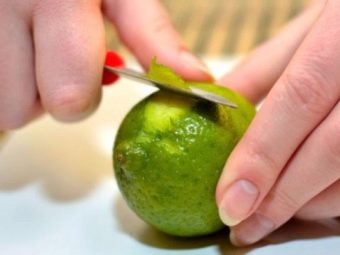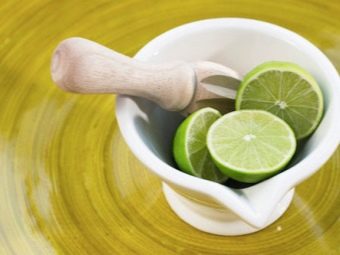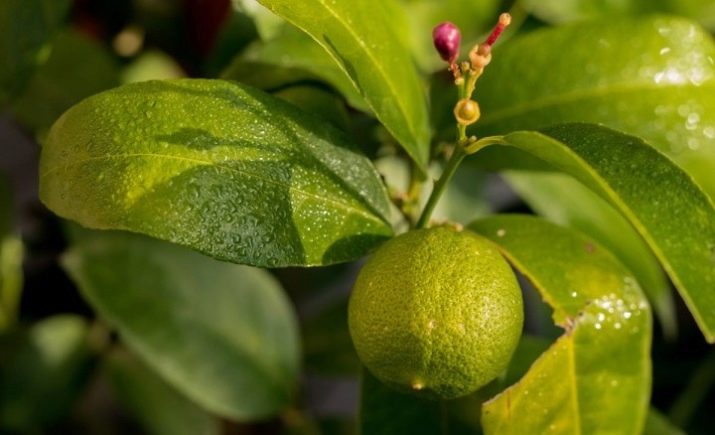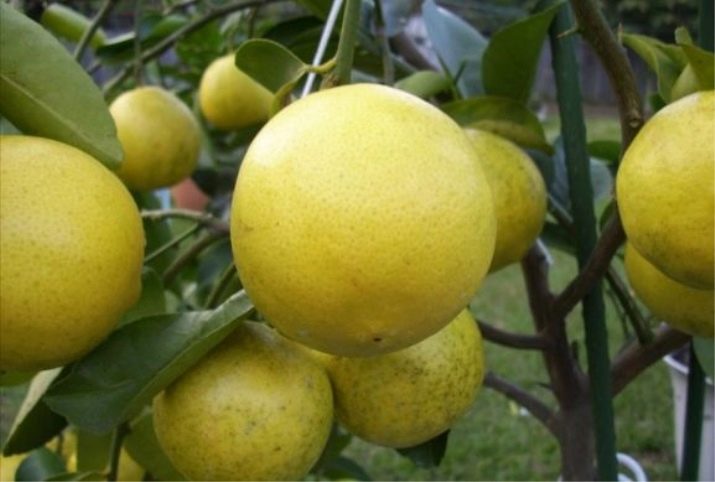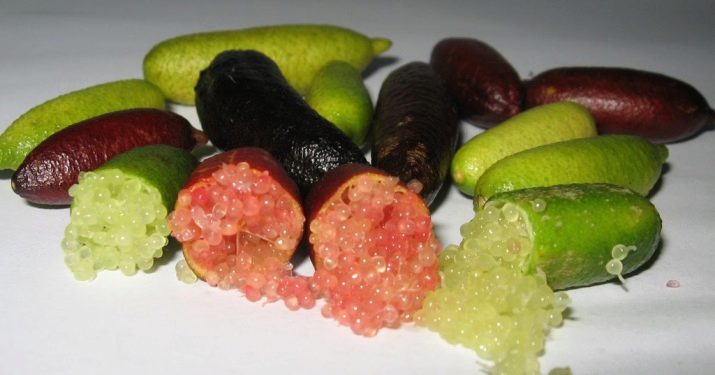Lime: what is it, how to choose and use?
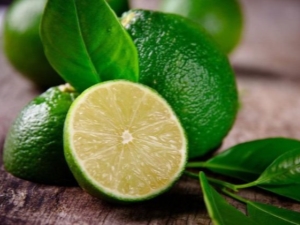
Not everyone knows that the green limes are citrus fruits. In addition, it is not a separate variety of the familiar lemon to all - it is a completely different unique plant with its own taste. Fresh fruits and lime leaves are widely used in the kitchens of many nations of the world, complementing and improving the recipe of the dishes, and the essential oil obtained during its industrial processing is part of cosmetic and medical products. It is the rich composition that endowed the lime tree fruits with beneficial and healing properties.
How does the fruit grow and look?
Lime is a low spreading tree (height varies from 1.5 to 5.5 meters) with thick branches. His crown has a slightly rounded shape, a large number of branches, on each there are thorns. The leaves are oval, with a smooth surface, the color is dark green. A flowering tree is covered with white flowers (up to 2 cm in diameter).
Mature fruit oval, with a diameter of about 5 centimeters. The flesh is quite juicy, greenish hue. It tastes sour. There is a pleasant fresh scent. Lime fruits have thin skin, either greenish yellow or pure green.
The period of flowering and fruiting at the lime tree lasts the whole year. Already in the third year of life, the plant begins to bear fruit. The peak is at the end of autumn - the beginning of summer (May-June). High fees are observed in August-October.
The most common varieties of lime are "Mexican", "Persian", "Kafrsky", "Palestinian" and "Finger". However, besides these popular varieties, today you can find specially bred hybrid species - limequat (lime with kumquat) and limonlime (lime with lemon). Much of the cultivation of this culture occurs in India, Indonesia, Egypt, Mexico, Brazil, Sri Lanka, the United States and West Africa.
Is it a vegetable or a fruit?
Lime is a fruit, a representative of citrus, from the family of ruta, the fruits of which grow on the tree. Outwardly, it resembles a lemon, but in taste, they differ significantly from each other. For example, lime is not as sour as its “yellow brother”. In addition, there is a difference in external data - size and color. About 89% of the pulp is water only. The rest is valuable vitamins, especially ascorbic acid (vitamin C), macro- and microelements, fiber, fats, carbohydrates and organic acids.
Composition
The energy ratio of the 100-gram serving of fruit (BJU as a percentage) is as follows: 0.85: 0.31: 8.2%.
Chemical composition of lime:
- beta carotene;
- choline;
- vitamin A;
- vitamin C;
- vitamin E;
- vitamin group B - B1, B2, B3, B4, B5, B6, B9;
- vitamin D;
- vitamin K;
- vitamin H;
- vitamin PP;
- Omega-3, Omega-6 (fatty acids);
- potassium;
- calcium;
- magnesium;
- sodium;
- phosphorus;
- iron;
- manganese;
- copper;
- sulfur;
- zinc;
- selenium;
- essential acids - lysine, tryptophan, methionine;
- tocopherol;
- retinol;
- riboflavin;
- thiamine;
- folic acid;
- linoleic and linolenic acid.
Benefit and harm
All the benefits of green lime are concentrated in its pulp, which contains a huge amount of water and the chemical elements necessary for the human body. Proper use of the fruit and compliance with the daily norm will significantly enhance the overall health, as well as relieve some ailments and prevent their appearance.
Beneficial features
- strengthens the immune system - its protective functions protect against colds, infectious and viral diseases;
- has a cleansing effect, freeing the body from toxic substances, heavy metals, radionuclides;
- blood circulation and capillary conditions are improved;
- processes of renewal of tissues and cells are launched;
- maintains normal blood cholesterol levels;
- inhibits premature aging, synthesizing natural collagen in skin cells;
- work of the digestive system organs is normalized;
- has a widening and cleansing effect on blood vessels, preventing the occurrence of blood clots;
- eliminates bad breath, for example, after drinking a cup of coffee;
- normalizes the bowels;
- suitable for diet, as it promotes fat burning;
- brain activity is stimulated, improving memory and attention;
- excellent prophylactic against stomatitis;
- strengthens the gums, preventing their bleeding;
- there is an increase in blood pressure;
- It has a healing effect on flu, sore throat and other respiratory diseases;
- increases overall tone, gives strength and energy;
- normalizes the nervous system, controlling emotional well-being in general;
- cures insomnia and excess anxiety;
- essential lime oil stimulates the production of gastric juice;
- relieves problems with constipation;
- improves the condition of intestinal peristalsis;
- indicated for urological and genital infections;
- accelerates the growth of bone tissue, especially teeth;
- has anti-inflammatory effect;
- a compress of lime slices will have a healing effect on varicose veins;
- Citrus-based cosmetics improve the condition of the skin, giving it a healthy tone and radiance.
Despite its great benefit, green citrus has a number of contraindications for use. Doctors do not recommend to use this product to people with high acidity of the stomach. This is due to the natural feature of lime in a large volume to stimulate the production of gastric juice.
In addition, the harmful effect is in the case of existing ulcers, gastritis and pancreatitis. It is also not in the best way reflected on the tooth enamel, therefore, after the segment eaten, it is necessary to rinse the mouth cavity with water.
The list will complement the individual intolerance of the product. The risk of an allergic reaction to citrus fruits is very high. Before use, it is better to consult with a specialist.
Calorie content
The nutritional value of 100 grams of the product is only 16 calories. These include proteins (0.9 g), fats (0.1 g) and carbohydrates (3 g). In addition, lime pulp is rich in valuable fiber (2.9 g), ashes (0.29 g), and natural sugar (1.8 g). The presence of essential oils gives the fruit a specific aroma of freshness.
Types and varieties
"Mexican"
"Mexican", or real lime is most common in tropical stripes. The local climate is the most suitable for growing this variety. Differs in small fruits, which are used mainly for the production of essential oil.
"Tahiti Variegate"
"Tahiti variegate" is a rare kind of lime tree. Fruits ripen striped, and leaves variegated. The skin is smooth, thin. Color - pale yellow. Especially appreciated for a large amount of juice. The taste is characteristic - sour.
"Variegata"
"Variegata" has the peculiarity of blooming more than once per season - this indicates that it belongs to remontant varieties of culture. Bushes grow sprawling, spines on them a little.
"Rangpur"
Rangpur, or mandarin-lime, is distinguished by orange peel and reddish flesh. In taste it resembles the same mandarin, only twice as sour as a classic lime.
Of the features stand high fees and the average height of the tree. It will perfectly fit into your home interior due to its decorative appearance and, surprisingly, purple bark. Thin twigs are filled with dark leaves with a small number of spines. Young shoots are also painted in purple. Homemade lime is dissolved in beautiful flowers. There is survival rate in the pot and resistance to cold temperatures.
The pulp of ripe fruit contains a lot of juice and ascorbic acid, which makes them very acidic. Fruit is ideal for making marmalade.
The round representative of the Australian varieties is the tallest of all - a 10-meter tree. Fruits resemble a pear or a large ball. The skin is thick, rough. Inside the light yellow or pale green flesh.Ripe fruits are used for cooking, drinks.
Many people choose this particular variety for growing at home. A beautiful sprawling tree emits a unique scent of essential oils, and pinkish flowers bloom on the branches.
"Palestinian sweet"
"Palestinian sweet" grows in the lands of the Middle East. There is a high yield and decorative presentation of the fruit. Flowering and fruiting last year round, beautiful white flowers appear on the trees. A growing bush at home will fill the room with a pleasant, fragrant aroma of freshness.
The shape of the fruit is spherical. The rind is yellowish, not very dense. They taste juicy and tender. Unlike other varieties, the "Palestinian" is not peculiar to citrus sourness, it comes to replace sweetness with a little tartness.
This variety is used for making jam, jams, sorbet and carbonated drinks. In addition, some national cuisines add lime to meat and poultry dishes, thereby emphasizing the taste, making it more saturated and refined. Fruit peel goes into industrial production of concentrated oils.
By the way, you can find the additional name of the variety - "Indian", which is explained by the main cultivation sites - India and Egypt.
Particularly appreciate this particular grade for the ability to alleviate the condition and cure colds, viral infections. It is worth buying a homemade tree of sweet lime for two reasons: an excellent decorative look and healing properties.
"Kafrsky" or "Kaffir"
Lime's homeland is Asia. He was widely known for the unique properties of his leaves. Dried can be replaced with the necessary in the kitchen bay leaf, as they are similar in smell.
Such fruits are not too juicy, but they emanate a characteristic fresh aroma. You can grow a tree at home, then it will be filled with pleasant and clean air. In addition, indoor lime has a beneficial effect on human well-being: stabilizes pressure, improves digestion, compensates for the lack of vitamin C, strengthens the immune system.
"Deserted"
"Desert" - drought-resistant variety of fruit tree. The cultivation site is Australia. Differs unusual colors of leaves - they are gray-blue. For what he received a second name - "Eremocytrus gray." The branches are filled with thorns, which decrease with age. The taste of the fruit - refreshing with a noticeable sharpness. Used for sauces, drinks, jam, marmalade.
Neapolitanum
Neapolitanum is the oldest lime variety. Trees grow low, their growth and development is rather slow. Nevertheless, the fruits ripen very tasty, for which they are valued by chefs.
"Finger"
"Finger" lime grows in Australia, and the name is shared by the local fingerlaym. The fruits of this variety are narrow, similar to a chicken egg. Unlike his relatives, he has a rough skin. As for coloring, here one can observe green and even maroon fruits. The color of the pulp changes with the external data.
This lime has the lowest calorie content, so it is valid for people with overweight. Rich fortified composition guarantees a number of positive effects on the human body:
- immunity strengthening;
- protection against caries;
- normalization of the kidneys;
- increased hemoglobin in the blood;
- strong heart and blood vessels;
- bowel cleansing;
- inhibition of aging processes;
- vision improvement;
- filling the deficit of useful substances.
How to choose a citrus?
Today, the two most common lime varieties, Persian and Florida, are on the markets and in stores. They both differ in large pitted fruits.
When choosing a fruit, pay attention to the peel - its surface should be smooth and sufficiently elastic. Ripe lime greenish yellow. Best of all, if the skin has a uniform color, without spots and darkening.
Having tried the bought fruits, you should notice juicy, gentle pulp and slightly bitter taste.
Low-quality goods can be identified by some signs:
- the presence of stains of a different color;
- external damage, dents and cuts;
- visible signs of drying, rotting, wilting;
- the fruit is soft to the touch.
Discard the product if you feel the smell of rot, damp or mildew. Despite the decent appearance, odors can say with certainty about the deterioration of the product.
What can be done?
Delicate and spicy taste, fragrant flavor distinguishes lime from other citrus fruits used in cooking. The green fruits of this plant give the dishes a delicate and exquisite taste.
In fact, lime can replace the same lemon or any other fruit in the recipe. For this, its lobules, peel, squeezed juice or whole fruit can be useful.
Lime Jam
Ingredients:
- kilogram of limes;
- 2 tablespoons of salt;
- kilogram of sugar;
- 10 grams of cinnamon;
- 5 grams of cardamom;
- teaspoon ground ginger;
- 5 g cloves.
Recipe.
- First, sort out the purchased fruit. If bad ones get caught, cut off dark spots and rough parts. Place the prepared limes in a separate bowl.
- Boiled water should be salted and cooled. After that, fill the fruit completely. Leave to soak overnight. This method will relieve limes from bitterness, which will affect the taste of jam.
- Soaked fruits cut into cubes 3x3 cm.
- Pour the sliced lime in a cauldron, half-fall asleep with sugar and pour water. After it boils, add spicy spices. Cooking time about 7 minutes - the foam should appear.
- Fill the rest of the sugar, make a slow flame and stir until dissolved. Now you can make the fire medium, cook for another 10 minutes.
- Spoon remove the foam when it appears.
- In the prepared glass container (jars) we pour the hot jam by placing anise in each star.
- Next, we put a towel in the pan, put the jars and pour water. Cover with top covers. Boil it all for about 10 minutes. After extraction, immediately tighten the lids tightly.
- In the process of cooling, the lime slices in the jam can stick together and turn into a solid lump. To avoid this, it is recommended to shake the jars with contents every half hour.
- We leave blanks for the night with the lids down - so you check if the jam is leaking. If all is well - boldly hide the treat for the winter.
Lime sorbet
For the preparation of dessert will require only three components: water, sugar and a few limes.
Step by step recipe.
- Medium sized limes are suitable for sorbet - about 4 pieces.
- Sugar syrup is made as follows: in a skillet (or saucepan), mix a glass of sugar and the same amount of water. On medium heat wait for the mixture to dissolve.
- In the meantime, wash the limes (it would be better to dab them with boiling water) and peel them off. We ship it in sugar syrup. After boiling, let it boil for a few minutes. Turn off the fire. We are waiting for cooling.
- We survive juice from peeled limes (make sure that the bones do not fall into the dish). You will get about 200 ml of lime nectar.
- Strain the cooled syrup, thereby getting rid of the peel. It was used exclusively for flavor.
- In the sweet mix, send the juice of limes and mix. Dessert preparation needs to be poured into a form for freezing (any plastic dishes will do). Close, wrap with cling film and place in the freezer.
- Every half hour you have to mix the lime mass with a fork. Only in this way you will get an even, uniform sorbet without lumps and ice.
- After about 5 of these manipulations, the dessert will be ready.
- For lovers of dense ice cream cooling time is 7 hours.
Tkemali sauce
Delicious spicy dressing for meat dishes is prepared quite simply. From the ingredients fit:
- olive oil (100 g);
- hot pepper (one);
- garlic (1 clove);
- Lime juice (50 g);
- honey (30 g);
- fresh ginger root (h. spoon);
- balsamic vinegar (2 tsp.);
- salt, spices to taste;
- cilantro (a few leaves).
Instructions for cooking.
- Put pepper, ginger and garlic in a blender. All this is ground to the state of porridge.
- Pour in lime juice, balsamic vinegar, honey, season with salt and cilantro. Whisk.
- At the end slowly pour in olive oil, without ceasing to mix.
- It is recommended to serve salt before serving.
Surprisingly, in addition to recipes, lime essential oil has shown itself well in traditional medicine and cosmetology. Today, manufacturers saturate cosmetics with this concentrate. This is explained by the nutritional and beneficial qualities of the juice. Pure oil can act as an ambulance in case of skin damage.
- To treat the wound, you need the following drug: 20 drops of oil + 4 drops of lavender (juniper will do).
- Strengthen the action of your favorite moisturizer can add 8 drops of concentrate.
- Mask for problem skin: mix white clay with walnut oil and lime. Action time - 10 minutes. Next, wash off with water and treat with tonic.
- Anti-aging remedy: low-fat yogurt + macadamia oil + lime. Apply to face until completely dry.
- Remove warts and boils with clean undiluted fluid.
How to use?
The lime tree, more precisely, its fruits and leaves, are widely used in the culinary, medical and cosmetic field. It is the unique aroma and characteristic sourness that made lime one of the main components of Asian and Arab national dishes.
It is in perfect harmony with meat ingredients. Lime juice and whole slices are used as marinade for chicken and fish. Beef, lamb and pork, hard in their structure, soaked in its juice, become soft and juicy. Neither lemon nor orange can boast of such a feature.
Squeezed juice, zest and essential oil help to add extra flavor to sweet food and cocktails. On the basis of citrus juice are prepared various dressings and sauces, characterized by a special piquancy.
In the kitchen you can also notice the use of fresh leaves. But from the dried fruits of the lime tree are prepared unique spices that complement any dish with spiciness and delicate aroma. For example, national recipes of Iranian dishes are hard to imagine without dried leaves and lime fruits. Indians are used to salting and pickling whole fruits. Grated peel is a decorative component that decorates drinks and desserts.
How to store at home?
Proper storage of the product will preserve its beneficial substances to the full. It is best to keep fresh limes in containers in a cool, dry place. Such conditions provide a shelf life of about 3 weeks.
Room temperature is also acceptable, but they can only last about a week for them to remain fresh and tasty.
You should not buy a large amount of fruit at one time, since you will not have time to use the whole product in 20 days. In this case, they wither, become rough and covered with black spots. From such fruits should get rid of.
A suitable method for preserving limes is freezing. Just squeeze out all the juice, and rub the peel. Well suited form for ice, where you want to pour the juice. Pack the grated zest into bags and send it all into the freezer. The shelf life of the product in this form is quite large.
Bone Growing and Care
Experts say that lime tree is quite unpretentious. It successfully takes root in almost any soil. For its cultivation suitable sandy and rocky soils with low fertility. In fact, the development of citrus plants strongly depends on soil and climatic conditions. A suitable soil will be a self-prepared soil mixture of loam type, mined in the depths of the arable layer.
It is easy to care for a tree, the main thing is to closely monitor the temperature regime.The plant is so afraid of the cold that when it drops to 2 degrees, its roots can suffer. Deciding to grow lime at home, you must decide on the place. This plant is thermophilic, for full growth in need of sunlight only in the morning. The rest of the time can help phytolamp.
All gardeners want to see at home a beautiful, smelling tree with ripe fruits. To do this, it is important to monitor the indoor temperature - in spring and summer not less than 30 degrees, in autumn and winter - to 15.
In the summer, it is recommended to irrigate with warm water - once a day is enough. For these purposes, suitable mechanical humidifier.
Closer to spring, homemade lime tree enters a phase of accelerated growth. From this point on, you can use top dressing that will support its proper development. Fertilizers must be purchased exclusively for citrus crops in specialized stores.
Lime watering is a moistening of the upper layers of the soil as it dries. No need to pour the plant - it threatens the formation of fungal infections in the roots. For irrigation, it is better to use rain, river, distilled water. Its temperature should not be lower than 20 degrees.
Young lime is recommended to replant every year, as it grows quickly. As for mature trees, it is enough to change the upper layer of soil.
The lime tree is a truly unique plant that can grow not only in the tropical forests of Asian and southern countries. It is quite suitable for home cultivation. Such an ornamental shrub will not only decorate the room, but also fill it with a fresh citrus scent.
In addition, with a few lime fruits, you can always maintain your physical well-being in normal condition. We can not say about the culinary possibilities: a couple of drops of lime juice emphasize the taste of any dish.
The main thing is to purchase a fresh and high-quality fruit that can be stored for up to two weeks. Optionally, you can save citrus for a longer time, for example, for the winter. In this case, it is worth resorting either to freezing, or to blanks such as jam, jam or sorbet.
What is more useful: lemon or lime? See the answers in the next video.





